12-Year-Old Girl in 1975: “I Sacrificed Myself So My Family Would Be Left Alone”
Today, on trial day 65 of case 002/02, the ECCC Trial Chamber heard Civil Party Ms. Seang Sovida, age 51 and Witness Mr. Uth Seng., age 59.
Today, also, the Supreme Court Chamber published its decision on Nuon Chea’s requests to call witnesses on appeal. The Chamber decided on the three witnesses to be heard first: SCW-5, SCW-4 and SCW-3. You can read the decision in full here.
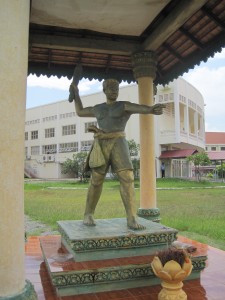
Lok Ta Dambong Dek: The Lord of the Iron Staff. This is a picture of the statute that stands outside the Courtroom. (picture by Kate Cronin-Furman on her blog here.)
At the Court, civil parties are not under oath when present before the court. Witnesses, on the other hand, if they are Buddhist, swear this oath before Lok Ta Dambong Dek, “The Lord of the Iron Staff,” whose statute stands outside the Courtroom.
I will answer only the truth, in accordance with what I have personally seen, heard, know, and remember. If I answer falsely on any issue, may all the guardian angels, forest guardians and powerful sacred spirits destroy me, may my material possessions be destroyed, and may I die a miserable and violent death. But, if I answer truthfully, may the sacred spirits assist me in having abundant material possession and living in peace and happiness along with my family and relatives forever, in all my reincarnations.[1]
To read more about Civil Parties in international tribunals, as this is the first one that has allowed them, read this great overview by Eric Stover, Mychelle Balthazard and K. Alexa Koenig in the International Review of the Red Cross.[2]
—
After starting her testimony with her hands folded in prayer to thank the court for this opportunity. Madame Civil Party Ms. Seang told the court about the 1st of January Dam Worksite.
To wit, as was detailed when this Chamber started hearing testimony about it, the 1st January Dam is one of the six worksites set out in the Closing Order of Case 002/02, where crimes against humanity, as defined in Article 5 of the ECCC law, were allegedly committed by the defendants, Nuon Chea and Khieu Samphan.
Specifically, the Closing Order alleges that the defendants are responsible for:
- inhumane acts through attacks against human dignity
- enslavement
- extermination
- murder
- other inhumane acts through enforced disappearances
- other inhumane acts through forced marriage
- persecution on political grounds
- persecution on religious grounds
Paragraph 358 of the Closing Order alleges that “tens of thousands of people participated in the construction of the 1st January Dam.” It states that “everyone, workers and cadres, lived in a constant state of fear of being arrested and taken away to be killed.” [Id. at paragraph 362.]
It is also alleged that workers at the construction site “could not speak or move freely. Whistles or loud speakers were used to gather the workers, who worked according to set times without rest or with strictly controlled periods of rest. Most teams worked night shifts. There was a fixed quota of soil to dig and carry per day and those who could not meet the quota were punished.” [Id. at paragraph 359.][3]
Civil Party Ms. Seang was born in Quarter 5 in Phnom Penh in 1964. Her father is Seu Chebseang, her mother Mao Kimyan, her husband Mok Brodetueasua and she has two children. She is currently a Public Servant in the Ministry of Interior.
Ms. Marie Guiraud, International Civil Party Lead Co-Lawyer, started by reading from document number C-222531 with English ERN: 01063843 to confirm her age.
Ms. Guirard started by confirming that Ms. Seang, the Civil Party, was born in 1964 and not in 1967 as her identity card says. Ms. Seang explained that she was an orphan when she got her ID and that her uncle changed her name and date of borth to protect her.
Ms. Seang confirmed that she was in Phnom Penh on April 17, 1975 when Pol Pot’s forces “liberated” the city. She was evacuated on April 18. She and her family were able to rest for a month in a location in Kampong Cham and then near a Pagoda. After six months she was evacuated again.
She told the Court how she and her family were interrogated because they were “April 17 People.” (For testimony before the court on what April 17 People were and how they were treated, see this post).
Ms. Seang’s family was accused of being capitalist and interrogated. Ms. Seang said: “I didn’t tell them the truth, I told them lies.”
She was 11 or 12 years old at that time.
At that village, Ms. Seang’s sister was forced to marry with a man she didn’t love. Ms. Seang explained that her sister was 15 or 16 and did not consent to the marriage. Her mother did not consent to the marriage either but “we consented because we feared what would happen.”
Then, Ms. Seang, at that time 11 or 12 years old, “volunteered” to go to the 1st of January Dam worksite.
Mr. Koumjian, International Co-Prosecutor, would later clarify what she meant by “volunteer” but the following is what she first explained under Ms. Guirard’s questioning.
Ms. Guirard read from Ms. Seang’s interview with the Office of the Co-Investigating Judge (OCIJ), document number E 307/6.1.6, ERN in English 01063819:[4]
“It was a real sacrifice for my family. If someone went to work for the Khmer Rouge, then they would not have a reason to blame my family.”
Ms. Guirard then asks her what she had meant by “sacrifice.”
“I was young. I would do anything so that they would be at peace. I would not mind being exhausted. It was my expectation at the time that my family would be left alone. I don’t know if my decision was correct at the time. “
January 1st Dam
Ms. Seang told the Court that ten of them went together from her village to the 1st January Dam Worksite. First they took a motorboat where there were 30 or 40 people and it took them two days and one night to get there. On her first day at the worksite she was familiarized with the tools and such, and then, on the second day she started working.
She said she worked along the Stung Chinit River far away from the main road and far away from the sleeping quarters.
Ms. Seang also said that she was not part of the first batch of workers to arrive at the Dam Site but the second batch. She estimated she arrived in late January of 1977 and stayed for about 3 months.
Her sleeping quarters were, first about 1 or 2 kilometers away from the work place and then they were 5 kilometers away from the worksite.
The routine work, she said, was to carry earth and soil from canal to Dam Site.
Her unit consisted of 100 workers from Brosab district. She was the youngest at age 11 or 12. The average age, according to her was below 30. Most were teens in their sixteen’s and seventeen’s.
“I was the youngest. People said I was too young, that I should have stayed with mom. They asked if I was still breastfeeding.”
Ms. Sean clarified to the court that she carried less earth than others. Mostly she collected water and brought it to the workers.
She also clarified that there was no specific quota for her but there was a quota for the group she was in. She spelled out that she was “forced to work.”
“I was hard working because I didn’t want any blame on me nor on my family.”
One time she fainted.
“One time I collapsed…I was so exhausted,” Ms. Seang said, “I had not had enough sleep. I was ill. I was carried away to my sleeping quarters.”
Meetings
Ms. Seang explained that the big meeting were not frequent but smaller ones within the unit were. Their purpose, she said was to push us to work as hard as possible and to complete the work before other villages.
Ms. Seang explained that the theory behind the meetings was self-criticism: “We had to watch over one another to catch the mistake,” she said.
Ms. Sean then repeated five slogans from the period that she membered being spoken about in those small meetings:
- “Angka had many eyes like a pineapple.”
- “The historical wheel was in motion and if you interfere with your arm or leg you would be crushed!”
- ”The Great Leap Forward.”
- “To keep is no gain, to kill is no loss.”
- “We had to interrupt the capitalist in ourselves.”
The big meetings, she said, was only about the work assignment. “We were told the country was liberated,” she explained. There were shouts of “Bravo, Bravo, Bravo” and “Long Live the Revolution.”
Ms. Seang also said that there were many revolutionary songs played daily over the loudspeakers: “They were about comrades and so on and so forth,” she said according to the official translation of the court.
“There were no romantic songs played over the loudspeakers,” she then added.
—
The floor was then turned over to Ms. Song Chorvoin, Deputy Co-Prosecutor.
She started by asking Ms. Seang about her family. Her mother was a home-maker but her father was soldier. Ms. Seang could not tell what rank he had other than solider. Under cross-examination later she would confirm that he was a soldier.
Ms. Seang told the court that her father always concealed his biography. Her mother thought that “Sihanouk was the initiator that created the Khmer Rouge regime,” and “she [her mother] was waiting to tell anyone that [her husband] was a soldier.”
Ms. Song proceeded to ask about the Wat Baray Choan Dek Pagoda.[5]
“I was told not to approach that Pagoda,” Ms. Seang indicated. “Some people said,” she continued, “that the breasts and limbs of women were cut-off and the rest [of the body] was hung in the Pagoda. I was told not to ask any further. “
Forced marriages
Through the questioning of Ms. Song, the deputy co-prosecutor, Ms. Seang told the court about her sister’s forced marriage together with 21 other couples.
There was a meeting at nighttime, Ms. Seang said, where she attended although she was very young. Angka read out a list and announced that this woman would marry this man, she told the court.
“We wondered how those people got their name on that list. I ran away to tell my mother. She tried to say that my sister [15 or 16] was too young. But she was told not to disobey because the ‘historical wheel was in motion and if you interfere with your arm or leg you would be crushed!’”
Her sister then told her “that she would not marry that man, he was our neighbor,“ Ms. Seang testified, “but she was forced to and she could not refuse. “ The couples were each given a set of mosquito nets and a blanket, according to Ms. Seang.
Extermination of her family
Mr. Nicholas Koumjian, International Co-Prosecutor, was given the floor soon after. He asked her further about her family.
“My mother, my father, my siblings, all killed,” Ms. Seang sobbed. “Only I survived because I was working very far. They killed all my family members.
Ms. Seang stopped and could not continue. Twenty-six long seconds passed after which Mr. Koumjian said: “If you need more time, that’s fine.” Ms. Seang composed herself and continued.
“New people were considered as their enemies. Whatever we did was wrong. We had no freedom of movement…we could not practice our religion –workers did it secretly–,” she said.
“Did you have any freedom of speech?” Mr. Koumjian asked, “Say at a meeting, could you tell them to reduce the working hours for example?”
“No,” Ms. Seang answered, “we could not challenge the working conditions. We could only speak about them to our closest colleagues.”
Mr. Koumjian then asked to explain what she had meant by “choosing” to go the 1st January Dam. Ms. Seang explained that she had wanted to go because she was told there was better food at the Dam. “If we didn’t choose,” she said, “we would be selected anyway. No one dared to refuse. “
Mr. Koumjian finished his line of questioning by asking her how tall she was then and how tall she is now, as she had said that she was tall for her age at 12.
Ms. Seang said that she was 1.2 or 1.3 meters high at the time. “I was lucky,” she then added “because I didn’t get taken away . . . when I was young I quite enjoyed the work . . . .’
Cross-Examination
Mr. Victor Koppe, Co-Lawyer for Nuon Chea, started the cross-examination by asking why she hadn’t mentioned the 1st January Dam site in her March 26, 2010 OCIJ interview at all.
Ms. Seang said simply, that she was told to give a brief statement at that time.
Mr. Koppe then pointed out that the supplementary material that does mention the 1st January Dam, was submitted the 22 of April of 2014, which, as Mr. Koppe pointed out, 2 or 3 weeks after the Closing Order for this case.
“Were you approached by anyone?” asked Mr. Koppe.
Ms. Seang said that she was told to go see a lawyer regarding case 003 and 004 and there I was asked about the 1st January Dam.
“Volunteering”
Mr. Koppe then came back to what she had meant when she had said she volunteered to go to the 1st January Dam.
Ms. Seang explained that her parents had disagreed but that there was nothing they could do. She said that she did not want to go do farm-work because she was afraid of the worms and that’s why she volunteered to go to the Dam. She again said the she sacrificed herself so that her parents would not be blamed. Her parents were not happy but “my elder siblings consoled them that I would anyways have to go later.”
Lunch break?
Mr. Koppe came back to what he’s being trying to confirm throughout the diverging testimonies on the Dam Site. “Was the lunch break from 11 to 1 or 11 to 2?” he asked.
Ms. Seang responded that she did not have a watch and she cannot remember.
Father
Mr. Koppe then pushed on why her father had not been found out to be a solider of the Lon Nol regime if, as Ms. Seang had said earlier in the day, according to Koppe, that “everyone knew” he was a solider.
“Maybe they suspected him,” Ms. Seang retorted. “But,” she continued, “I was interrogated one day and I lied. I said that we were rice farmers and that was what was written on his bio.”
Her brother-in-law, on the other hand, she said, who had been a pilot in the Lon Nol Army was found to have a military uniform in his backpack in the village-wide searches that were conducted at that time. Ms. Seang did not know if the searches were common as she had left the village as soon as her sister had married the pilot.
Ms. Seang, as civil parties before court have the right to, finished with a statement she had prepared.
One of the questions she asked of the two defendants at the end was:
“They kept saying that they did not know about what happened and that what happened was done by the lower cadre. Do you mean that you, who were at the upper level, did not have any authority at all during the regime? You did not control the country at all?”
You can watch her closing statement in full here, starting at 59:13.
Khieu Samphan and Nuon Chea exercised their right to remain silent.
______________
[1] Source for the quote is: http://www.wrongingrights.com/2012/07/all-hail-the-iron-god.html But see Cf. for a different version: https://cambodianlaw.wordpress.com/2012/06/04/repost-witness-oath-in-cambodian-criminal-procedure/ or William and Mary Law School’s blog for a full text of the Cambodian oath: https://law.wm.edu/academics/intellectuallife/researchcenters/postconflictjustice/studentsummerblogs/2009blogs/RebeccaWharton/swearing-an-oath-in-cambodian-court.php. [2] The article also mentions in footnote 13 that: “Civil parties have since been included in other criminal tribunals, including the International Criminal Court (ICC) and the Special Tribunal for Lebanon, although the full extent of participatory rights differs from court to court.” (Emphasis my own). [3] [NB: The closing order quoted above carries a prominent disclaimer: “The content in Closing Orders are allegations, which need to be proven through adversarial hearings. As such, the allegations . . . can not be treated as facts unless they have been established through a final judgment.” Such adversarial proceedings are ongoing now and the substance of these reports.]
[4] Mr. Lars Olsen, Spokesperson for the Public Affairs Sectionof the Extraordinary Chambers in the Courts of Cambodia has clarified in an email to me that: “All written record of interviews are classified as confidential until they have been referred to in court and/or admitted as evidence during trial. Once they have been declassified, they will be published on the website. This process usually takes at least 4 weeks.” As such these quotes are not official. They’re what is heard publicly at court and attempted to be faithfully transcribed. [5] From the closing order: “367 . . . The nearby Wat Baray Choan Dek Pagoda was known as a place where people were taken to be killed.”

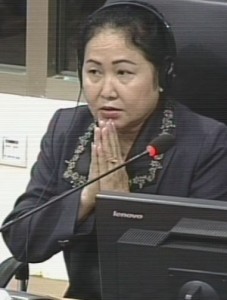
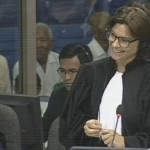
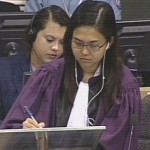
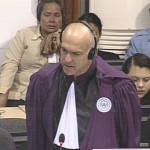
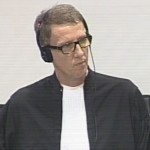
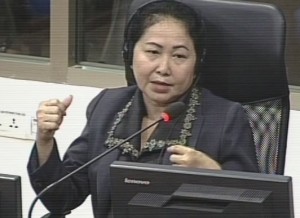
[…] testimony begun the day before, the Trial chamber continue to hear Witness Mr. Uth Seng, […]